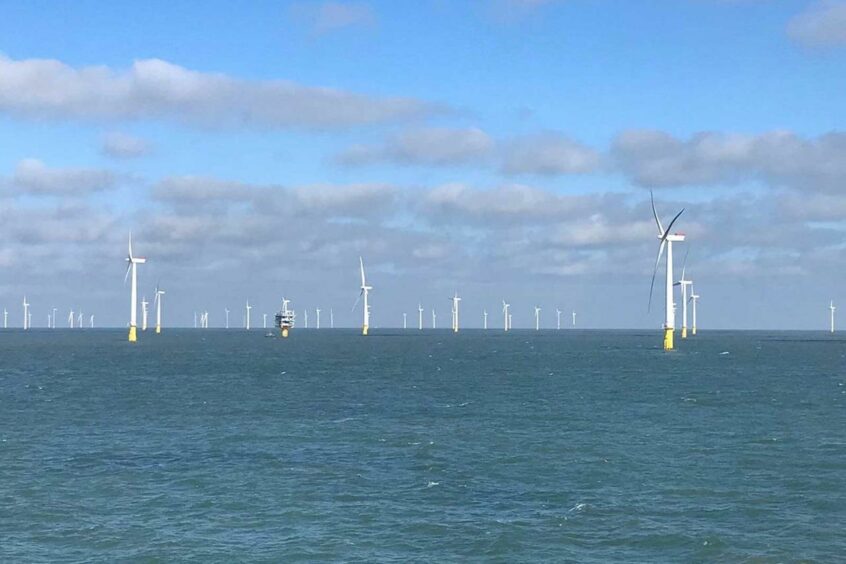
Masdar has a target of reaching 100 GW of power by 2030. To achieve that, the company is seeking a range of opportunities, with the UK hitting the right mix.
The Abu Dhabi-based company completed its acquisition of a 49% stake in the 3 GW Dogger Bank South project on February 29. Speaking to Energy Voice the same day, Husain Al Meer, Masdar director of global offshore wind and UK, said the UK would remain a key market for the company.
“We have a 100 GW target and we look at offshore wind from a strategic angle. We like to invest in countries where we see great prospects for growth, with healthy business ecosystems and a ready state of ports and infrastructure,” Al Meer said.
Dogger Bank South
Masdar will work on the £11 billion Dogger Bank South project with RWE. The two have previously worked together on the London Array.
The new project will be split in two, DBS East and DBS West, each with 1.5 GW of capacity and covering 500 square km.
Masdar CEO Mohamed Jameel Al Ramahi, in a statement, said the investment “demonstrates our commitment to developing Masdar’s offshore wind capacity and expertise as an important component in our pursuit of the target of 100GW renewable energy portfolio capacity by 2030. We look forward to a successful collaboration with RWE over the years to come.”
Masdar teamed up with RWE at COP28, held in Dubai in December. Construction could begin by the end of 2025, with the first 800 MW of power coming online in 2029. The two sites should be fully commissioned by the end of 2031.
The next step is submit development consent orders, due in the second quarter of this year, followed by securing contracts for difference (CFD).
The Dogger Bank South deal was not the only Masdar announcement for the week. It also broke ground at two battery energy storage system (BESS) projects in the UK. The facilities, in Rochdale and Stockport, will have joint capacity of 55 MW.
Masdar established its offshore wind HQ in the UK in 2021. In 2022, with its purchase of Arlington Energy, marked the focus of the UK as Masdar’s battery storage hub.
Grid squeeze
Al Meer expressed confidence in the UK’s plans to expand its grid capacity, needed to unlock the offshore wind target. “Transmission and the grid is really important for the transition. It has been a big topic since 2022.”
The UK government has taken steps recently to tackle some of the challenges in accessing the grid. Al Meer noted the removal of “zombie projects”, that lacked credentials and financial backing. The first come, first served approach was not working, he continued.
“However, there is still work to be done to achieve the 50 GW target”, he said, noting the increases in energy storage, in infrastructure and even in demand, such as electric vehicles. “There is a need to deploy more capital in the UK.”
All parties – National Grid, the Distribution Network Operator (DNO) and operators – must “invest to accommodate all those sides and projects that are still, right now, struggling to connect to the grid. The speed of investment is really important.”
The government has shown some signs in recent months of downgrading energy transition goals and some politicians have questioned the economics of net zero plans.
Scaling up
For Masdar, though, the UK’s commitment to the energy transition remains unquestioned. “We’ve been investing in the UK for the last 16 years. The business case for the energy transition is becoming robust and commercially viable.”
Masdar’s Al Meer noted the commitment from COP28, where countries committed to tripling renewable energy. Sometimes the detail takes time and requires priorities, but from our side we are quite optimistic, particularly when it comes to the UK market.”
Masdar has around 20 GW of capacity on its books. To scale up to 100 GW within six years, it will need to focus on major projects.
Al Meer noted the company’s interest in a number of destinations around the world and the “major role” that offshore wind will play in this growth. If the UK wants to capture Masdar investments, it will need to compete globally with other areas. Tackling the challenges – such as the grid and local support facilities – will help the company make those big choices.
Recommended for you

